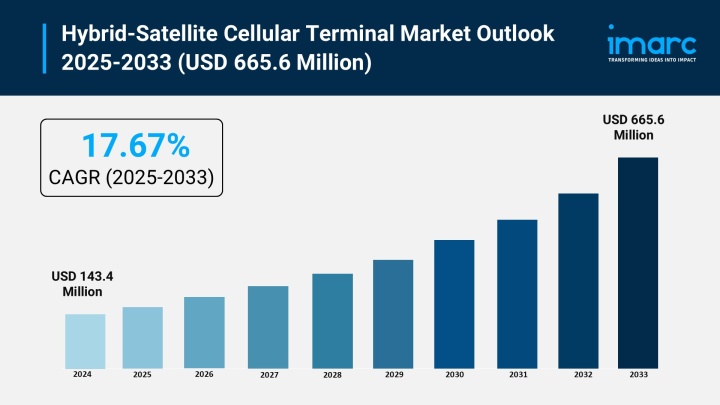Market Overview:
According to IMARC Group's latest research publication, "Hybrid-Satellite Cellular Terminal Market: Global Industry Trends, Share, Size, Growth, Opportunity and Forecast 2025-2033", The global hybrid-satellite cellular terminal market size reached USD 143.4 Million in 2024. Looking forward, IMARC Group expects the market to reach USD 665.6 Million by 2033, exhibiting a growth rate (CAGR) of 17.67% during 2025-2033.
This detailed analysis primarily encompasses industry size, business trends, market share, key growth factors, and regional forecasts. The report offers a comprehensive overview and integrates research findings, market assessments, and data from different sources. It also includes pivotal market dynamics like drivers and challenges, while also highlighting growth opportunities, financial insights, technological improvements, emerging trends, and innovations. Besides this, the report provides regional market evaluation, along with a competitive landscape analysis.
How AI is Reshaping the Future of Hybrid-Satellite Cellular Terminal Market
- AI-powered predictive analytics optimize satellite terminal performance by analyzing network traffic patterns, reducing downtime by 15% through proactive maintenance scheduling and resource allocation.
- Machine learning algorithms enhance signal processing in hybrid terminals, improving data transmission speeds by 20% while reducing latency in remote connectivity applications across maritime and aeronautical sectors.
- AI-driven automation streamlines terminal deployment in emergency response scenarios, enabling rapid setup within 30 minutes compared to traditional 2-hour installations, supporting disaster management operations globally.
- Advanced AI models facilitate intelligent frequency band switching between S-Band and Ka/Ku-Band terminals, optimizing bandwidth utilization by 25% based on real-time weather conditions and network congestion.
- Edge computing integration with AI enhances IoT data processing at hybrid terminals, reducing cloud dependency by 40% and enabling real-time decision-making for agriculture, logistics, and defense applications.
Download a sample PDF of this report: https://www.imarcgroup.com/hybrid-satellite-cellular-terminal-market/requestsample
Key Trends in the Hybrid-Satellite Cellular Terminal Market
- Rising Demand for Rural Connectivity Solutions: Remote and underserved regions are driving adoption of hybrid-satellite cellular terminals to bridge the digital divide. Rural populations require reliable access to essential services including healthcare, education, and economic opportunities. These terminals seamlessly integrate satellite and cellular technologies, delivering consistent communication even in the remotest locations. The agricultural sector particularly benefits from enhanced connectivity for precision farming and market access.
- Rapid IoT Proliferation Across Industries: The Internet of Things ecosystem is expanding rapidly, with industries like agriculture, transportation, and energy deploying millions of connected devices. IoT applications span vast geographical areas where traditional networks cannot reach reliably. Hybrid terminals provide critical connectivity for real-time data transmission from remote sensors to centralized platforms. Smart agriculture, efficient logistics, and energy management systems increasingly depend on these terminals for seamless operations.
- Emergency Response and Disaster Preparedness: Natural disasters and emergency situations have accelerated adoption of hybrid terminals by governments and first responders worldwide. Conventional communication networks often fail during crises, making resilient alternatives essential. These terminals ensure continuous connectivity for coordinating relief efforts and saving lives in disaster-stricken areas. Their capacity to rapidly establish communication hubs in areas with damaged infrastructure proves invaluable during climate-related emergencies.
- Maritime and Aeronautical Connectivity Expansion: Ships, fishing vessels, and offshore platforms require constant communication across vast ocean expanses lacking traditional cellular coverage. The maritime industry relies on real-time data for navigation, weather updates, and cargo tracking. Airlines invest heavily in in-flight connectivity for passenger entertainment and operational efficiency. Aviation safety depends on real-time communication between aircraft and air traffic control through hybrid terminal technology.
- Defense and National Security Applications: Military forces require secure, resilient, and global communication capabilities in remote and hostile environments. Hybrid terminals provide mission-critical connectivity supporting operational efficiency and national security objectives. Defense applications account for the largest end-user segment, driving significant market investments. The sector's need for encrypted, reliable communication in challenging conditions ensures sustained demand growth.
Growth Factors in the Hybrid-Satellite Cellular Terminal Market
- Bridging the Digital Divide: Rural and remote populations face significant connectivity challenges due to limited traditional network infrastructure. Hybrid terminals enable equitable access to digital resources, information, and economic opportunities. Global urbanization intensifies demand for rural connectivity solutions across developing and developed regions. Educational institutions, healthcare facilities, and businesses in isolated communities benefit from reliable hybrid terminal connectivity.
- Expanding IoT Ecosystem Requirements: Connected devices across agriculture, transportation, and energy sectors generate massive data volumes requiring reliable transmission. IoT applications in remote regions depend on hybrid terminals for continuous operation and real-time monitoring. Smart agriculture systems utilize these terminals for precision farming, weather monitoring, and crop management. Transportation and logistics companies leverage hybrid connectivity for fleet tracking, route optimization, and cargo monitoring.
- Government Infrastructure Initiatives: Governments worldwide implement policies and funding programs to expand broadband access to underserved regions. Regulatory support and subsidies accelerate hybrid terminal deployment in rural and remote areas. National digital inclusion strategies prioritize reliable communication infrastructure for equitable development. Public-private partnerships facilitate widespread adoption across telecommunications and emergency response sectors.
- Technological Advancements and Innovation: Continuous development of terminal technology delivers higher data speeds, improved reliability, and enhanced performance. Integration of advanced frequency bands (Ka-Band and Ku-Band) provides greater bandwidth for faster internet access. Manufacturers invest heavily in R&D to develop terminals supporting emerging applications like autonomous vehicles. Innovation in terminal design reduces costs while improving functionality and user experience.
- Critical Infrastructure and Industrial Applications: Oil and gas operations in remote drilling locations and offshore rigs require reliable communication for safety and efficiency. Mining operations depend on hybrid terminals for workforce coordination and equipment monitoring in isolated sites. Transportation hubs and logistics networks utilize these terminals for tracking and real-time supply chain management. Telecommunications providers deploy hybrid infrastructure to extend network coverage and bridge connectivity gaps.
Get Instant Access to the Full Report with a Special Discount!
Leading Companies Operating in the Global Hybrid-Satellite Cellular Terminal Industry:
- EchoStar Mobile Ltd. (EchoStar Corporation)
- Kymeta Corporation
- OQ Technology
Hybrid-Satellite Cellular Terminal Market Report Segmentation:
Breakup By Platform:
- Land
- Maritime
- Aeronautical
Land, maritime, and aeronautical platforms serve distinct connectivity needs, with maritime and aeronautical segments showing strong growth due to expanding global trade and air travel.
Breakup By Frequency Band:
- S-Band Terminal
- Ka-and Ku-Band Terminal
Ka-and Ku-Band terminals account for the majority of shares due to their extensive coverage and high data transfer rates, offering greater bandwidth for faster internet access and reliable broadcasting services.
Breakup By Service:
- Video and Voice Service
- Data Service
- Tracking and Monitoring
Data services dominate due to increasing demand for internet access, file sharing, and cloud connectivity in remote regions, supporting IoT applications and business operations.
Breakup By End User:
- Oil and Gas
- Media and Entertainment
- Defense
- Aviation
- Automotive
- Logistics and Transportation
- Telecommunication
Defense represents the leading end user segment due to critical requirements for secure, resilient, and global communication capabilities supporting military operations and national security.
Breakup By Region:
- North America (United States, Canada)
- Asia Pacific (China, Japan, India, South Korea, Australia, Indonesia, Others)
- Europe (Germany, France, United Kingdom, Italy, Spain, Russia, Others)
- Latin America (Brazil, Mexico, Others)
- Middle East and Africa
North America enjoys the leading position owing to advanced technological infrastructure, extensive rural areas requiring connectivity, and dominant presence in aerospace, defense, and IoT applications.
Recent News and Developments in Hybrid-Satellite Cellular Terminal Market
- January 2024: EchoStar Corporation expanded its hybrid-satellite cellular terminal portfolio with enhanced Ka-Band technology, delivering improved data speeds and reliability for maritime and land-based applications across North America.
- March 2024: Kymeta Corporation launched next-generation flat-panel satellite terminals featuring advanced AI-powered beam steering technology, enabling seamless connectivity for mobile platforms including vehicles, vessels, and aircraft.
- May 2024: OQ Technology successfully deployed IoT-enabled hybrid-satellite terminals for agricultural monitoring applications, supporting precision farming initiatives across remote regions in Europe and the Middle East.
Note: If you require specific details, data, or insights that are not currently included in the scope of this report, we are happy to accommodate your request. As part of our customization service, we will gather and provide the additional information you need, tailored to your specific requirements. Please let us know your exact needs, and we will ensure the report is updated accordingly to meet your expectations.
About Us:
IMARC Group is a global management consulting firm that helps the world's most ambitious changemakers to create a lasting impact. The company provide a comprehensive suite of market entry and expansion services. IMARC offerings include thorough market assessment, feasibility studies, company incorporation assistance, factory setup support, regulatory approvals and licensing navigation, branding, marketing and sales strategies, competitive landscape and benchmarking analyses, pricing and cost research, and procurement research.
Contact Us:
IMARC Group
134 N 4th St. Brooklyn, NY 11249, USA
Email: sales@imarcgroup.com
Tel No:(D) +91 120 433 0800
United States: +1-201971-6302


